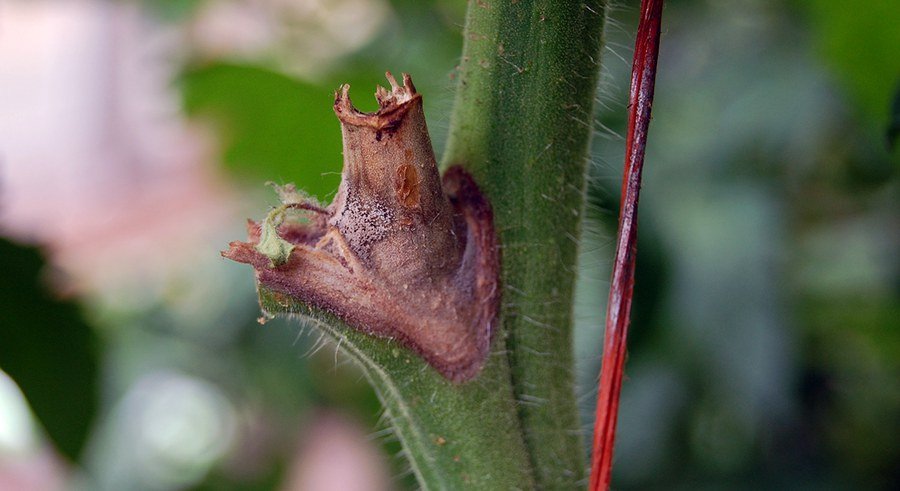Jun 10, 2020Issues to watch for in greenhouse and high tunnel tomatoes
After a cold, dreary spring, the weather is starting to improve. This means we need to be watching for issues in the greenhouse and high tunnels and develop a scouting plan to monitor problems.
In this article, we will talk about some common problems and their management in greenhouse and high tunnel tomatoes.
Blossom End Rot in Greenhouse and High Tunnel Tomatoes
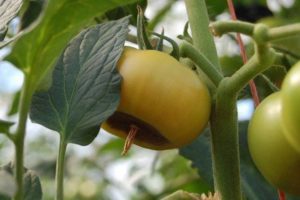

On the plant nutrition front growers are receiving their first plant analysis results back and are finding that the calcium levels in the tomato and pepper tissues are lower than desired. The low levels of calcium in the plant tissues can be easily explained by the cool, gray humid, weather that has been blanketing our area this spring which limited both transpiration rates and calcium uptake.
Historically many researchers have focused on localized calcium deficiencies in tomato and pepper plants as a precursor to developing Blossom End Rot in tomatoes and peppers. While this has been the operating premise for most of my career, there seems to be new research that may encourage a totally different management approach in preventing Blossom End Rot in the greenhouse.
Plant stress and growth spurts in the greenhouse appear to divert calcium away from developing fruits resulting in Blossom End Rot. If growers can minimize plant stress and do not over-fertilize or over-stimulate their plants (bullish growth versus toned growth) less blossom end rot may be observed.
Two researchers, Lim C. Ho and Phillip J. White (A Cellular Hypothesis for the Induction of Blossom-End Rot in Tomato Fruit, 2005) stated that direct application of calcium sprays to developing fruit would reduce the incidence of Blossom End Rot (BER) in tomato fruits. Other researchers have found that the application of calcium sprays to developing tomato fruits were very labor-intensive, did not reduce the incidence of BER, and actually decreased the number of marketable fruits. While growers can consider on-farm experimentation with foliar calcium products their usage does not appear to be the panacea that we once thought it was.
In summary, the best ways to prevent blossom end rot in greenhouse tomatoes are:
- Monitor soil or media salinity. Elevated soluble salt levels increase plant stress and with stress comes an increase in BER incidence.
- Monitor moisture levels and do not let the media or soil get too dry between watering and/or let it become waterlogged. Remember stress = BER.
- Limit plant growth spurts. Excessive or bullish growth increases the incidences of BER.
- Reduce light intensity under periods of high light (summer) to reduce plant stress (Consider 30% shade cloth).
- Maintain moderate humidity levels with good airflow.
Thrips in greenhouse tomatoes
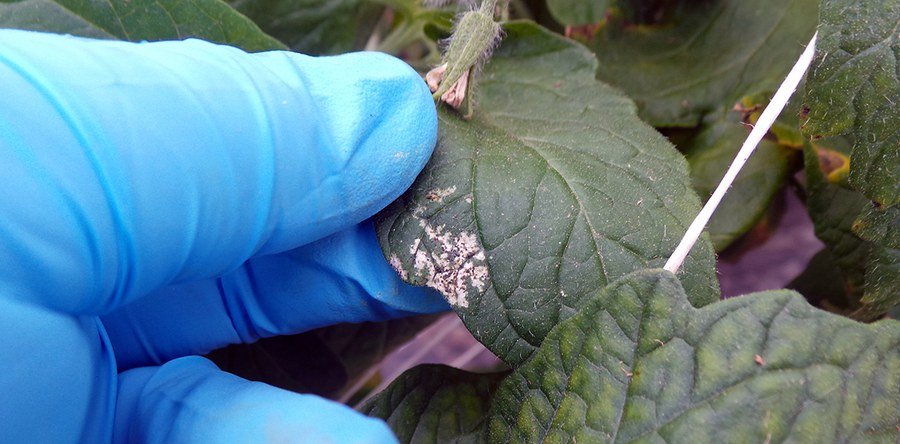

Thrips seem to be a problem every year, but the stakes get much higher when there are weeds or floriculture crops in the greenhouse with tomatoes. Many weeds and annual flowers can be reservoirs for tomato spotted wilt virus (TSWV). If thrips feed on infected weeds or plant materials and then feed on tomatoes they can readily transmit TSWV virus to your tomato crop.
While virus transmission is the greatest threat posed by thrips their feeding can cause a golden “flecking” of the tomato fruit that impacts its visual appeal to customers. Western flower thrips should be a grower’s greatest concern since they have the capacity to transmit TSWV. Recommended bio-control agents in tomato greenhouses include: Strateolaelaps scimitus, minute pirate bugs (Orius spp), and Neoseiulus cucumeris.
Mycoinsecticides containing Beauveria bassiana (BotaniGard, Mycotrol), Isaria fumosoroseus strain FE 9901 (NoFly WP), and Metrarhizium anisopliae can be used for thrips control on tomatoes. Labeled chemical insecticides for use on greenhouse tomatoes include insecticidal soap (M-Pede), paraffinic oil (Ultra-Fine Oil), chlorfenapyr (Pylon), and azadirachtin (Azatin).
Tomato pinworms in greenhouse and high tunnel tomatoes
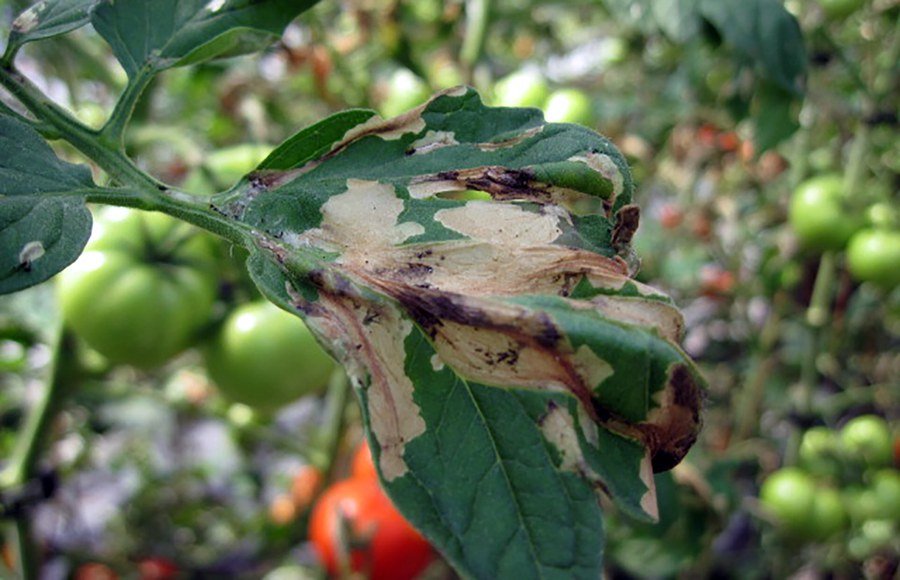

Tomato pinworms were detected in a tomato greenhouse in the western part of the state. It is believed that tomato pinworm pupae (from last summer) overwintered in the greenhouse and began attacking the tomato plants shortly after they were transplanted in the greenhouse.
The larva of the tomato pinworm is a small orange-brown to a purplish-black caterpillar that can produce a blotch-like mine on the leaves or tunnel slightly under the skin of the tomato fruit. If left uncontrolled this pest can produce 4-5 generations a year resulting in both defoliation and fruit damage. After feeding the tomato pinworm larva will drop to the ground and will pupate at or near the soil surface.
Growers wishing to manage tomato pinworm should consider using mating disruption (NoMate TPW) or light traps. Trichogramma spp. have also been used in Canada as a bicontrol agent with some success. Insecticides labeled for Tomato Pinworm management in greenhouses include spinosad (Entrust SC), chlorfenapyr (Pylon), or cyantraniliprole (Exirel).
Botrytis in greenhouse and high-tunnel tomatoes
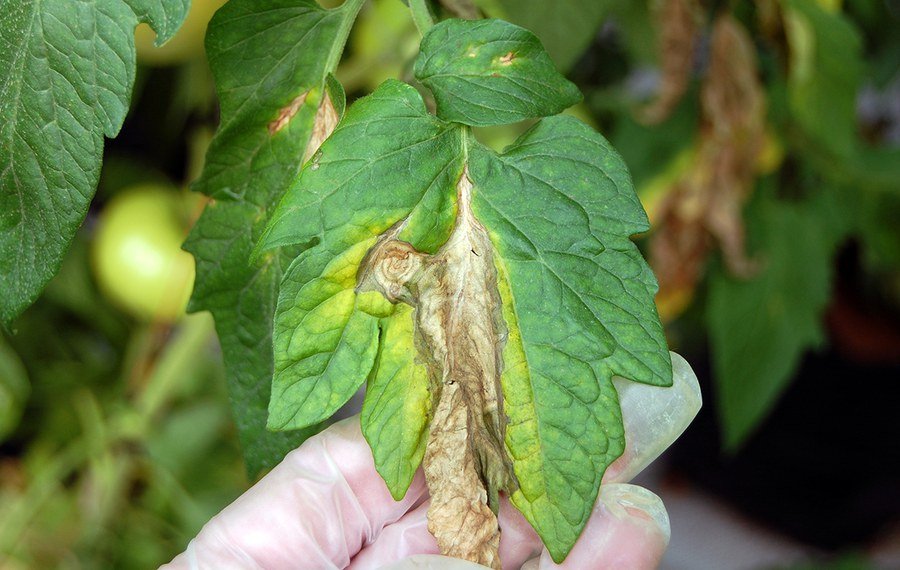

Cloudy, damp, gray weather that extends drying times and limits airflow is a recipe for Botrytis or gray mold. Common symptoms observed by growers include tan or brown lesions on leaves, brown cankers on stems, and blighted flowers. Under moist or humid conditions, a grower will notice a gray fuzzy bread-mold like growth on blighted plant parts including flowers, leaves, and stems. Botrytis management starts with limiting high humidity and leaf wetness in the greenhouse or high tunnel.
Horizontal airflow fans (HAF) are a grower’s best friend in warding off botrytis. Unfortunately, as I visit greenhouses around the state, I frequently encounter unplugged or missing HAF fans in some greenhouse operations. These fans are critical in moving the moist air out of the crop canopy and away from foliage, stems, and flowers.
High tunnels rely on natural ventilation to remove humidity and to dry the dew off the foliage. Due to our colder temperatures, growers have had to keep their high tunnel sides rolled down for extended periods of time which has created the perfect environment for botrytis outbreaks. High tunnel growers do not have a lot of alternatives when cooler weather limits natural ventilation. One possible solution being touted by some growers is to walk down the rows in the early morning and use a leaf blower to blow off some of the dew that is coating the foliage. While this is an added expense it may be a realistic option for growers that are faced with an abundance of cool, cloudy, wet weather.
Venting at sunset to evacuate moisture-laden air from greenhouses is often overlooked as a technique to reduce botrytis infection. Heating the cooler air drawn in from outside the greenhouse will lower humidity at night resulting in a growing environment that is less conducive to botrytis infection.
Plant debris can be a source of inoculum for botrytis infection. The removal of blighted foliage and flowers from the tomato plants will reduce the inoculum resulting in less infection. Growers should remove blighted foliage and flowers on warm, sunny dry days to lessen the likelihood of fresh wounds becoming infected from windblown spores.
Fungicides can be an effective tool in preventing and/or managing botrytis in the greenhouse. Fungicide resistant biotypes are common so growers must rotate FRAC (Fungicide Resistance Action Committee) codes to prevent resistant strains from developing. Chemical fungicides labeled for use on greenhouse and high tunnel tomatoes include Scala SC, Decree 50 WDG, Badge SC, etc. Bio-based fungicides can be a great alternative to chemical fungicides if resistance is noted in the greenhouse. Products like Bacillus subtillis (Cease), Streptomyces griseoviridis (Mycostop), Streptomyces lydicus (Actinvovate), and Extract of Reynoutria sachalinensis (Regalia PTO) can be utilized with most conventional chemical fungicides to provide control.
– Thomas Ford, Penn State University Extension educator
Top photo: Figure 5: Botrytis can colonize fresh wounds on cloudy gray days. Photo: Tom Ford, Penn State


